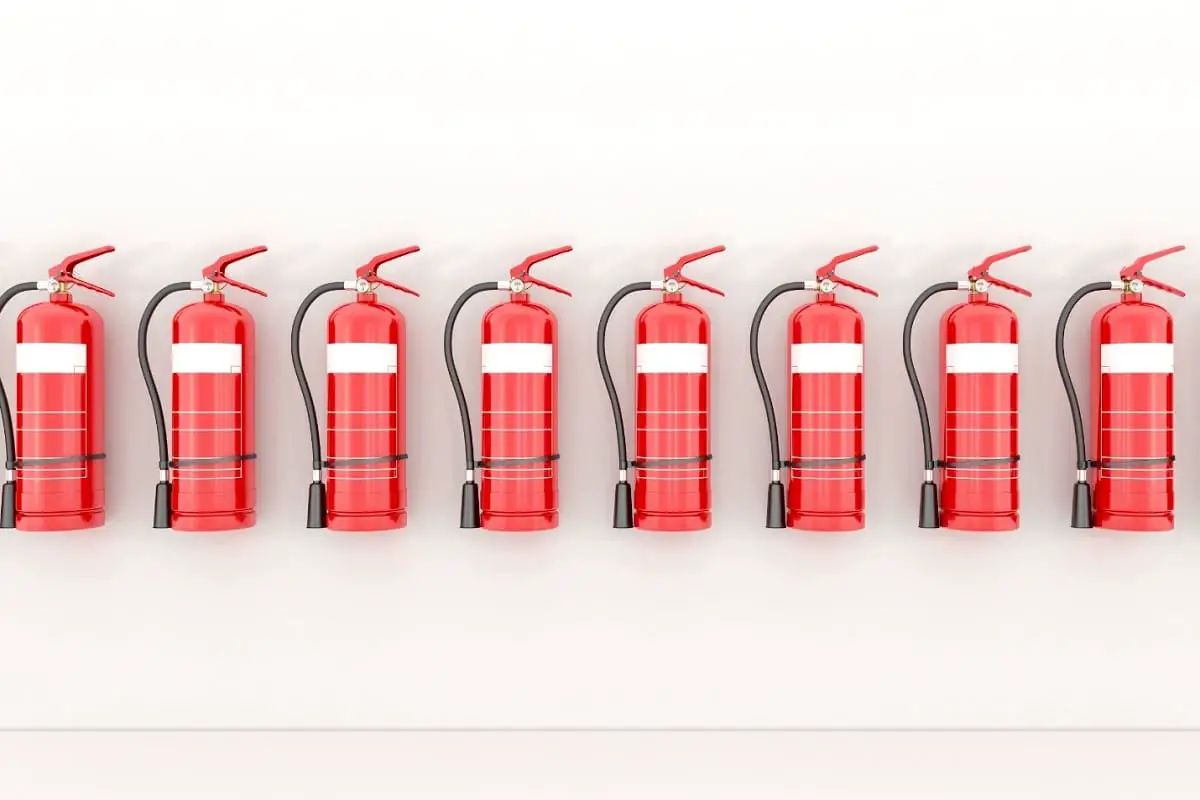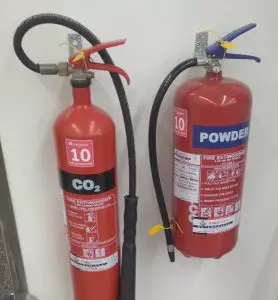Combustible materials are everywhere around us, and because of these materials, a small fire can rage out of control and get deadly in just a matter of three to five minutes. Having easy access to fire extinguishers is crucial.
This aticle discusses how many fire extinguishers you need in a specific, designated area.
General Fire Extinguisher Quantity Requirements
Carrying out a fire risk assessment will determine the number of fire extinguishers needed in a specific location.
As a general rule, you must have at least one fire extinguisher to cover 2100 square feet. Therefore, each area of 4300 square feet should have at least two fire extinguishers.
In simple words, for every additional 2100 square feet, you must have an extra fire extinguisher.
All fire extinguishers together should have a combined minimum fire rating of 0.065 x floor area (in square meters).

How Many Fire Extinguishers per Square Foot?
According to Occupational Safety and Health Administration (OSHA), a 2A or above-rated fire extinguisher must be provided for every 3,000 square feet of a protected building area.
The distance from any point of the protected area to the nearest fire extinguisher in the area must not be more than 100 feet.
A 10B or higher rated fire extinguisher must be placed within 50 feet of an area where more than 5 gallons of combustible or explosive liquids, or more than 5 pounds of combustible gas, are being used. This is a serious requirement that all companies operating in the industry must follow. This requirement, however, does not apply to the fuel tanks of motor vehicles.
If you’re looking for fire extinguishers, here are a few good ones to check out on Amazon:
Amerex B500 5 lb ABC Dry Chemical Fire Extinguisher
4-Pack Buckeye 10914 10 lb ABC Multipurpose Hand Held Fire Extinguishers with Wall Hooks
Amerex 90-417 B417 2.5 lb ABC Fire Extinguisher with Wall Bracket
As an Amazon Associate, SelectSafety earns commissions from qualifying purchases made through links in this post.
Where Should a Fire Extinguisher be Located?
Common sense dictates that fire extinguishers must be placed where they are easily accessible in case of an fire incident so somebody can grab an extinguisher and control the fire unil the fire department arrives.
Accessible fire extinguisher locations include frequently used areas and paths of travel such as:
- Doorways
- Hallways
- Pillars
- Kitchens
- Garages
- Bare walls
- Entry ways and foyers
- Outdoor awnings
A fire extinguisher must be located where it is visible from multiple angles. That means open sight lines and placing extinguishers away from shelves and other clutter. You also need to mount signs such as arrows to indicate where a fire extinguisher is located.
According to the NFPA the height of a fire extinguisher is important as well:
If a fire extinguisher weighs less than 40 lbs, the extinguisher’s top cannot be more than 5 ft. from the ground, and the bottom must be at least 4 inches off the ground.
If a fire extinguisher weighs more than 40 lbs, the extinguisher’s top cannot be more than 3.5 ft. above the ground, and the bottom must be at least 4 inches from the ground.
How Far Apart Should Fire Extinguishers be Spaced?
Fire extinguisher spacing requirements depend on the area’s size, the type of fire extinguishers, flammability of materials and potential fire hazard locations.
Here are guidelines on how close your fire extinguishers should be to each other depending on the hazard type:
Class A Fire Extinguisher Spacing
Hazards: Everyday combustible materials (wood, paper, cloth, plastic, rubber, etc.)
Spacing: One extinguisher for every 3,000 square feet
Maximum travel distance: 75 feet
Class B Fire Extinguisher Spacing
Hazards: Flammable gasses or liquids (natural gas, gasoline, etc.)
Maximum travel distance: 50 feet
Class C Fire Extinguisher Spacing
Hazards: Electrical (electrical cables, short circuits, machinery)
Spacing and maximum travel distance: Dependent on Class A or B potential hazards
Class D Fire Extinguisher Spacing
Hazards: Combustible metals
Maximum travel distance: 75 feet
Class K Fire Extinguisher Spacing
Hazards: Fats and cooking oils
Maximum spacing and distance: 30 feet
What Is the Maximum Distance between Fire Extinguishers?
There should be at least one fire extinguisher for every 2100 square feet of space as a general rule. The distance between extinguishers will depend on the fire extinguisher type, area size and layout, and hazard location.
- In a house or apartment, fire extinguishers should be every 50 feet or less.
- In a restaurant kitchen or laboratory, fire extiguishers should be every 30 feet or less.
- In an automotive, welding or machine shop, fire extinguishers should be every 50 feet or less from each other.
- In larger areas such as warehouses, factories, cafeterias, convention centers, semi-outdoor display areas, hotel meeting rooms, etc. fire extinguishers should be mounted every 75 feet or less. Large signs are required in these places to ensure people can see each fire extinguisher from a distance when the space is crowded.
These are just estimates, however. If the quantity, density and flammability of materials within a space are high (and therefore high fire risk and fire spread risk), then there should be more fire extinguishers mounted closer together. If the likelihood of a fire breaking out is low, and the intensity of the fire is low and more localized (e.g. paper or a trash can), then you can get away with wider spacing. When in doubt, err on the side of more fire extinguishers, rather than less!
How Many Fire Extinguishers for an Apartment Building?
You must install at least one fire extinguisher on every level of each building, as well as in the basement, laundry room, and parking garage if there is one.
According to the California Code of Regulations, at least one fire extinguisher must be provided on each apartment building floor. At least one fire extinguisher should be located next to the staircase on each floor in multi-story buildings.
How Many Fire Extinguishers for a Warehouse?
Fire extinguishers must be positioned at all potential fire points in warehouses, usually on an exit route. Authorities should clearly sign them, and a weekly inspection must be carried out. However, the fire extinguisher count for a warehouse will depend on the warehouse’s area and potential hazards. The NFPA recommends having one extinguisher in every 3000 square feet area.
How Many Fire Extinguishers for a House?
A fire can start anywhere in a home; hence it is your duty to protect your property. If you have a multi-story home, place a fire extinguisher on each floor in a place where it is easily accessible, such as the hallway.
You should also have a fire extinguisher in your kitchen, garage, attic, basement, dining area and hallways.
How Many Fire Extinguishers for an Office?
Offices are light hazard buildings and have minimal fire risk. Essentially, there should be a minimum of two fire extinguishers on every floor unless the floor area is minimal, i.e., less than 1000 square feet. Most offices have Class A fire extinguishers, so there must be one for every 3,000 square feet.
How Many Fire Extinguishers for a Restaurant?
The NFPA categorizes fires in restaurant kitchens as Class K fires because of the high heating rates of vegetable oils and other cooking products. Restaurant kitchens must have at least one Class K fire extinguisher.
How Many Fire Extinguishers for an Automotive Shop?
Car repair and automotive workshops pose a range of fire risks. They commonly use flammable liquids and high-tech equipment, plus a potentially explosive mix of dust and lubricants that can easily catch fire. An automotive shop should have at least one A, B, and C type fire extinguisher.
How Many Fire Extinguishers for a Barn?
According to the NFPA, a barn must have A, B, and C-type fire extinguishers close to all exits and within a 50 feet distance from any point in the barn. All workers must be trained to use fire extinguishers, and hazard checks must take place as scheduled.
In Conclusion
We hope that by now, you are aware of the required fire extinguisher quantity in homes, offices, shops, restaurants, and other places of business. The simplest way to protect belongings and lives from fire is to ensure you have enough fire extinguishers installed in a designated space.

